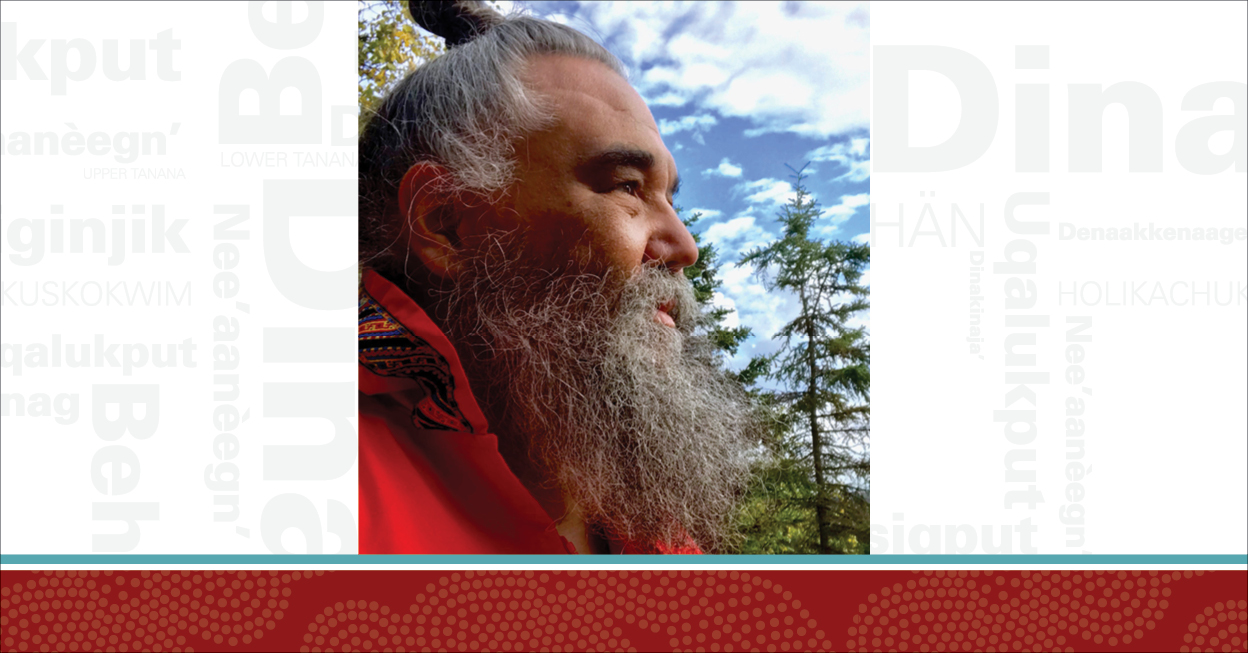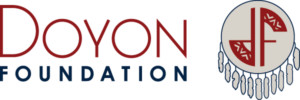 “Dina xiyo ngitlith: Our thoughts are powerful”
“Dina xiyo ngitlith: Our thoughts are powerful”
An artist and songwriter who grew up in Ts’eldahthnu (Soldotna) on the Kahtnu (Kenai) River, George Holly is a content coordinator with Doyon Languages Online whose learning is guided by the wisdom of Chief Peter John: “God has given us each a language to praise Him with.”
George’s parents are the late Joanne Holly of Holy Cross and the late George Holly, Sr., who came to Anchorage, Alaska, when he was 11, in 1951. George’s maternal grandparents are the late Nick and Nellie Demientieff of Holy Cross. Nellie Demientieff grew up in Anvik and together Nick and Nellie raised 10 children, including Sam Demientieff, Irene Catalone, Sugar Merculieff, Tiny Devlin and Lolly Demientieff.
George is the owner of Holly House, a guest house on the Kenai River. His language is Deg Xinag, the language of Alaska Native people of the Lower Yukon and Innoko Rivers.
Doyon Foundation: Take us back to early days of learning your language. Who and what inspires you?
George Holly: My first language teacher and mentor was Ellen Savage, wife of my grandpa’s first cousin, Pius Savage. I was 24 years old when Ellen taught me my first words. She took my hands into hers and told me to never let her words fall from me.
I learned from Ellen that language can be what she would call dinayetr — our breath — and what she’d refer to simply as the good life. I’ve learned that language is not only a vehicle of communication but a good work. It affirms community life, service and time-tested generational experience for good thought.
DF: In addition to providing learning units since joining Doyon Languages Online last year, you remain a diligent student of Deg Xinag. How do the two roles fit together?
GH: I’ve been learning my language for 25 years, sometimes through weekly distance education classes, sometimes listening to and studying the printed text of oral histories, and sometimes through university courses or language development institutes. In 1999 I moved to Shageluk, near Holy Cross in our cultural area of Western Alaska, to be nearer to speakers of Deg Xinag. I stayed nine months.
My teachers have included many Elders, among Deg Xit’an people and also Tlinglit and Dena’ina people. I’m amazed to hear the same spirit of loving guidance in each. (When performing at Camai a few years back, I heard Yup’ik Elders speak to their dance groups backstage and was stunned to hear that same uplifting and ennobling speech there. We all share it.) The Elders pass down what they had learned about life from their own “old people” about community traditions and right living with the world.
DF: That seems like your main point — that language is much more than getting across our thoughts.
GH: Learning and speaking one’s language has the potential to open things inside you, connect you in untold ways to the prayers and hopes, joys and knowledge of those who came before.
DF: You stress the value of listening when it comes to language learning.
GH: Listening, doing activities in the language, being open to what’s being said — these have all helped me learn my language. And working with kids. “Going North Song” and “The Squirrel Love Song” and “Naqanaga” are some of the songs I’ve written being sung across the state and the Yukon Territory.
Growing up outside of my cultural region I didn’t take part in much of the ceremonial life of our community. But I’m Deg Xit’an — one of “the local people” — and I’ve joked that it means wherever I was, I was one of the locals. It works to take part in the local life— supporting the local language is something needed, necessary and good.
How can you say you really lived in a place or really loved a place if you haven’t heard, supported, loved and spoken the language of a place?
DF: You are a talented songwriter; “Naqanaga (Our Language),” “Chenh ditr’al iy (Until We See Each Other Again)” and “Ani Chonh Igili’eyh (Over the Rainbow in Deg Xinag)” are some examples of songs you’ve worked on. What role do you feel music plays in language learning?
GH: I feel strongly about using my talents to support language revitalization. I write music for schools, with teachers, students in small groups and individuals – all with local language. Lorna Vent from Huslia said “music is for building a spirit.” I write music to help build that spirit and the intangibles to experience language in a personal way. Students I’ve worked with usually like to try to add more Native language once they feel it for themselves.
DF: Where does your work with Doyon Languages Online fit in to your goals as a language learner?
GH: Distance is a big challenge when it comes to being among speakers, learning the language and using it frequently. When I travel anywhere I try to visit places where I know language learning is happening and spend good time with folks.
Helping people overcome these challenges by developing units to people have online access to our language is part of why working for Doyon Languages Online has been so poignant and purpose-driven for me.
DF: You want to become more methodical about language learning. What would that look like?
GH: I’d like to learn more about moving beyond working with individuals. For instance, what can be done so that language takes on more life in a family context? How can culture camps and weekly or monthly or quarterly community events support intergenerational interaction in the language?
How could parents be empowered to use the language with their young ones and other family members? And since kids learn so quickly, how might roles be maintained when a child advances faster than adult family members? How can a social environment be built and supported so that local language use is favored and preferred?
Moreover, regarding language in groups: How does a community experience hope?
I believe the arts help in this area.
These are things I’d like to address. There’s so much to learn and share. Ting getiy dixet’a. Xogho ntr’ixetonik. The trail is awfully rough. We’ll work at it together.
DF: Any closing thoughts?
GH: When it comes to involving Elders working on Doyon Languages Online, Edna Deacon and Jim Dementi deserve mention. It wouldn’t happen without them. And I thank Doyon Foundation for the confidence it has in my role with Doyon Languages Online.
My language learning efforts are dedicated to Ellen Savage, my first teacher, and in memory of my dear folks who allowed me to be a person in my own skin and who were and are such encouragers of art and “the good life.” Dogidinh, xisrigidisddhinh sidithnaqay neg! “Thank you, I’m grateful, my dear parents!”
About Doyon Languages Online
Through the Doyon Language Online project, Doyon Foundation is developing introductory online lessons for Holikachuk, Denaakk’e (Koyukon), Benhti Kenaga’ (Lower Tanana), Hän, Dinjii Zhuh K’yaa (Gwich’in), Deg Xinag, Dinak’i (Upper Kuskokwim), Nee’anděg’ (Tanacross) and Née’aaneegn’ (Upper Tanana). The project officially launched in summer 2019 with the first four courses, now available for free to all interested learners.
Doyon Languages Online is funded by a three-year grant from the Administration for Native Americans (ANA), awarded in 2016, and an additional three-year grant from the Alaska Native Education Program (ANEP), awarded in 2017.
As Doyon Foundation continues to grow our language revitalization efforts in the Doyon region, we believe it is important to recognize people who are committed to learning and perpetuating their ancestral language. We are pleased to share some of these “language champion” profiles with you.
If you know a language champion, please nominate him or her by contacting our language program director at haytona@doyon.com. Language champions may also complete our profile questionnaire here. You may learn more about our language revitalization program on our website, or sign up to access the free Doyon Languages Online courses here.
